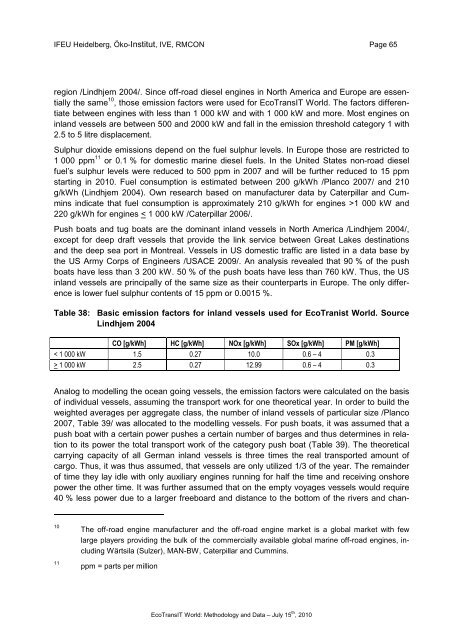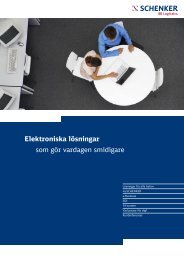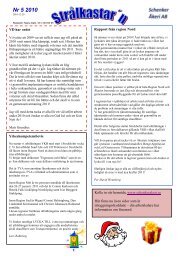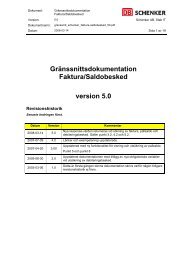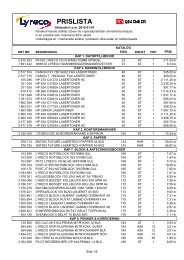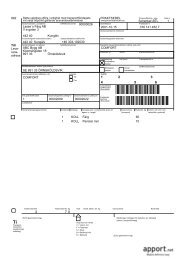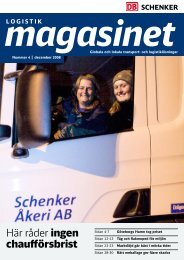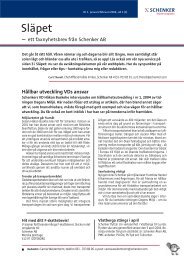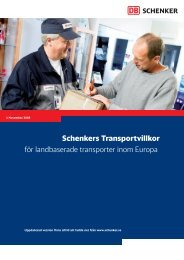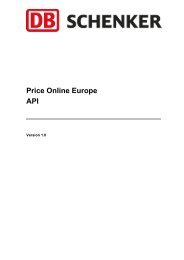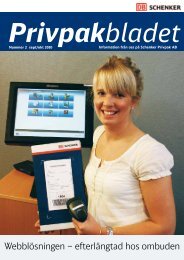Ecological Transport Information Tool for Worldwide ... - Schenker
Ecological Transport Information Tool for Worldwide ... - Schenker
Ecological Transport Information Tool for Worldwide ... - Schenker
Create successful ePaper yourself
Turn your PDF publications into a flip-book with our unique Google optimized e-Paper software.
IFEU Heidelberg, Öko-Institut, IVE, RMCON Page 65<br />
region /Lindhjem 2004/. Since off-road diesel engines in North America and Europe are essentially<br />
the same 10 , those emission factors were used <strong>for</strong> EcoTransIT World. The factors differentiate<br />
between engines with less than 1 000 kW and with 1 000 kW and more. Most engines on<br />
inland vessels are between 500 and 2000 kW and fall in the emission threshold category 1 with<br />
2.5 to 5 litre displacement.<br />
Sulphur dioxide emissions depend on the fuel sulphur levels. In Europe those are restricted to<br />
1 000 ppm 11 or 0.1 % <strong>for</strong> domestic marine diesel fuels. In the United States non-road diesel<br />
fuel’s sulphur levels were reduced to 500 ppm in 2007 and will be further reduced to 15 ppm<br />
starting in 2010. Fuel consumption is estimated between 200 g/kWh /Planco 2007/ and 210<br />
g/kWh (Lindhjem 2004). Own research based on manufacturer data by Caterpillar and Cummins<br />
indicate that fuel consumption is approximately 210 g/kWh <strong>for</strong> engines >1 000 kW and<br />
220 g/kWh <strong>for</strong> engines < 1 000 kW /Caterpillar 2006/.<br />
Push boats and tug boats are the dominant inland vessels in North America /Lindhjem 2004/,<br />
except <strong>for</strong> deep draft vessels that provide the link service between Great Lakes destinations<br />
and the deep sea port in Montreal. Vessels in US domestic traffic are listed in a data base by<br />
the US Army Corps of Engineers /USACE 2009/. An analysis revealed that 90 % of the push<br />
boats have less than 3 200 kW. 50 % of the push boats have less than 760 kW. Thus, the US<br />
inland vessels are principally of the same size as their counterparts in Europe. The only difference<br />
is lower fuel sulphur contents of 15 ppm or 0.0015 %.<br />
Table 38: Basic emission factors <strong>for</strong> inland vessels used <strong>for</strong> EcoTranist World. Source<br />
Lindhjem 2004<br />
CO [g/kWh] HC [g/kWh] NOx [g/kWh] SOx [g/kWh] PM [g/kWh]<br />
< 1 000 kW 1.5 0.27 10.0 0.6 – 4 0.3<br />
> 1 000 kW 2.5 0.27 12.99 0.6 – 4 0.3<br />
Analog to modelling the ocean going vessels, the emission factors were calculated on the basis<br />
of individual vessels, assuming the transport work <strong>for</strong> one theoretical year. In order to build the<br />
weighted averages per aggregate class, the number of inland vessels of particular size /Planco<br />
2007, Table 39/ was allocated to the modelling vessels. For push boats, it was assumed that a<br />
push boat with a certain power pushes a certain number of barges and thus determines in relation<br />
to its power the total transport work of the category push boat (Table 39). The theoretical<br />
carrying capacity of all German inland vessels is three times the real transported amount of<br />
cargo. Thus, it was thus assumed, that vessels are only utilized 1/3 of the year. The remainder<br />
of time they lay idle with only auxiliary engines running <strong>for</strong> half the time and receiving onshore<br />
power the other time. It was further assumed that on the empty voyages vessels would require<br />
40 % less power due to a larger freeboard and distance to the bottom of the rivers and chan-<br />
10<br />
11<br />
The off-road engine manufacturer and the off-road engine market is a global market with few<br />
large players providing the bulk of the commercially available global marine off-road engines, including<br />
Wärtsila (Sulzer), MAN-BW, Caterpillar and Cummins.<br />
ppm = parts per million<br />
EcoTransIT World: Methodology and Data – July 15 th , 2010


